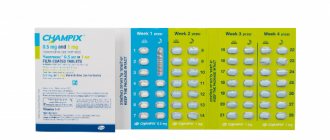Release form and composition
Dosage form – film-coated tablets: round, yellow, marked “25” on one side (10, 20, 30 or 50 pcs. in polymer jars; 10, 20, 30 or 50 pcs. in blisters, in one package may contain 10, 20, 30, 40, 50, 60, 80, 90 or 100 tablets).
Active ingredient: clomipramine hydrochloride – 25 mg.
Excipients: microcrystalline cellulose, colloidal silicon dioxide, croscarmellose sodium, magnesium stearate, hypromellose, titanium dioxide, lactose monohydrate, macrogol, iron oxide yellow dye.
Similar drugs
When considering analogues of Clomipramine, first of all, you need to pay attention to a number of medications that contain a similar active substance – clomipramine. In Russia, antidepressants with such a composition are practically not produced, so the products on sale are mainly imported. Analogs of Clomipramine:
- "Anafranil."
- "Clofranil."
In addition to tablets, there is also a solution on sale.
Pharmacological properties
Pharmacodynamics
Clomipramine is an antidepressant from the group of tricyclic compounds. Its action is associated with stimulation of serotonergic and adrenergic mechanisms in the central nervous system through inhibition of the reuptake of neurotransmitters. To a greater extent, the drug affects the uptake of serotonin, which, apparently, determines its effectiveness in the treatment of obsessive-compulsive disorders. The antidepressant effect develops already in the first week of treatment.
The drug also has antihistamine, anticholinergic and adrenergic blocking activity. The psychostimulating effect of the drug is less pronounced than that of imipramine, and the sedative effect is less pronounced than that of amitriptyline.
Pharmacokinetics
Clomipramine is rapidly and completely absorbed after oral administration. Its maximum plasma concentration is reached after approximately 1.5–4 hours. Connection with plasma proteins – 97.6%. Vd (volume of distribution) is 12 liters. Clomipramine is extensively metabolized to form an active metabolite, desmethylclomipramine.
The half-life in the terminal phase is 21 hours. The drug is excreted through the intestines (in the form of metabolites) and in the urine (unchanged and in the form of metabolites).
Fast and efficient
Judging by the reviews, Clomipramine shows first effectiveness within a few days from the start of the therapeutic course. The drug has a good effect on patients suffering from urinary incontinence during sleep, and is also effective for bulimia and is a strong analgesic. "Clomipramine" is an alpha-blocker that also has the effect of a choline blocker and an H1-histamine blocker.
When using Clomipramine, a wide list of pharmacological effects is observed. The drug is able to block 5-HT receptors, and also has a pronounced antihistamine effect. The use of Clomipramine shows good results in depressive syndrome, including in a number of specific situations. Clomipramine also fights the typical manifestations of depression (mental retardation, motor skills, depressed state), and also helps eliminate increased anxiety. A lasting clinical effect is usually achieved in the second or third week of the therapeutic course.
Indications for use
- Depressive states of various origins: organic, neurotic, larval, reactive, involutional and endogenous forms;
- Depressive conditions caused by chronic somatic diseases or chronic pain syndrome;
- Depression in schizophrenia and psychopathy;
- Presenile and senile depression;
- Obsessive-compulsive disorder;
- Panic disorder;
- Phobias;
- Cataplexy accompanying narcolepsy;
- Nocturnal enuresis in children over 5 years of age and adolescents.
Drugs containing (Clomipramine analogues)
Level 4 ATC code matches:
Doxepin
Ladisan
Ludiomil
Melipramine
Anafranil
Amitriptyline
Drug analogues: Anafranil , Clominal , Clofranil , Clomipramine , Anafranil SR .
Contraindications
Absolute:
- Children under 5 years of age;
- Alcoholism;
- Recent myocardial infarction;
- Congenital long QT interval syndrome;
- Concomitant use with monoamine oxidase inhibitors and for 2 weeks after their discontinuation;
- Lactation (or feeding should be stopped);
- Hypersensitivity to the components of the drug or other dibenzazepines.
Relative:
- Reduced seizure threshold;
- Severe liver/kidney diseases;
- Pheochromocytoma;
- Neuroblastoma;
- Hyperthyroidism;
- Diabetes;
- Concomitant use of steroid hormones.
There are no reliable data and clinical trials on the safety of Clomipramine during pregnancy, therefore, during this period of a woman’s life, the drug can be prescribed only if the expected benefits of therapy outweigh the potential risks for the intrauterine development of the fetus.
When else should you use it carefully?
As can be seen from the instructions, the doctor’s special attention should be focused on patients with cardiac disorders. Those who have been diagnosed with glaucoma (especially if it is the closed-angle type) require a specific attitude. The drug is used with caution if there is urinary retention, increased pressure in the ocular system and in severe liver disorders. If a tumor of the adrenal medulla is detected, Clomipramine can be used, but with constant monitoring of the situation. It is necessary to remember the increased risk of hypertensive crisis associated with a number of pathologies.
Instructions for use of Clomipramine: method and dosage
The tablets should be taken orally during or after meals.
In each case, the therapeutic dose is selected by the doctor individually.
Adult patients are usually prescribed 1-2 tablets (25-50 mg) 2-3 times a day. The maximum permissible daily dose is 250 mg (10 tablets), when used in a hospital setting - 300 mg (12 tablets).
The initial dose for children is 1-2 tablets per day. The maximum permissible daily dose for children over 10 years of age is 3 mg/kg, but not more than 200 mg.
During pregnancy
Currently, official information on the use of Clomipramine during pregnancy is insufficient. The medication should be used in this condition only in a limited format. It is assumed that tricyclic antidepressants can provoke disturbances in the development of the embryo. Based on this, in general, doctors recommend abandoning the course of Clomipramine during pregnancy. At the same time, in each specific case, the attending physician assesses the condition of the expectant mother, as well as the likelihood of risk for the child, and, based on a comparative analysis, makes a decision on how justified the therapy is.
If during pregnancy the patient took Clomipramine or other tricyclic antidepressants, and the therapy lasted until the birth of the child, there is a high probability of withdrawal syndrome in the baby in the first few hours after birth. This is manifested by shortness of breath and colic. The child sleeps a lot, may be irritable, and his blood pressure is higher or lower than normal. In addition, there is a possibility of spastic phenomena and tremor. To prevent such consequences, stop taking Clomipramine two months before the expected time of birth. It is also taken into account that the substance can pass into milk during lactation, therefore, when taking the drug, you should not breastfeed your child or give up tricyclic depressants during lactation.
Side effects
- Central nervous system: often - tremor, fatigue, headache, visual disturbances, myoclonus, dizziness; rarely - sensation of heat, taste disturbances, disorientation, agitation, anxiety, mydriasis, aggressiveness, mania, hypomania, impaired concentration, memory impairment, yawning, nightmares, sleep disturbances, tinnitus, delirium, depersonalization, hallucinations (most likely in older people and patients with parkinsonism), speech impairment, increased depression, ataxia, muscle tone disorders, paresthesia, convulsions; in some cases - glaucoma, increased psychotic symptoms;
- Cardiovascular system: rarely - electrocardiogram changes, increased blood pressure, arrhythmias, sinus tachycardia, postural hypotension, palpitation; in some cases - cardiac conduction disturbances, changes in the electroencephalogram;
- Digestive system: often – constipation, dry mouth, nausea; rarely - discomfort in the abdomen, anorexia, diarrhea, vomiting, increased transaminase activity; in some cases – jaundice, hepatitis;
- Hematopoietic system: in some cases - eosinophilia, thrombocytopenia, thrombocytopenic purpura, agranulocytosis, leukopenia;
- Metabolism: often – increased appetite, increased body weight;
- Endocrine system: often – enlarged mammary glands, galactorrhea, libido and potency disorders; in some cases - edema, syndrome of inadequate secretion of antidiuretic hormone;
- Dermatological and allergic reactions: rarely - itching, skin rash, photosensitivity;
- Other: often - increased sweating; rarely – increased body temperature.
special instructions
Before prescribing Clomipramine, it is necessary to monitor blood pressure, during treatment - peripheral blood patterns, and with long-term use - heart and liver function.
Patients prone to suicidal behavior during therapy, especially in the initial period, should be under constant medical supervision.
The use of electric shock during treatment with clomipramine is possible only under strict indications and under the close supervision of a physician.
The drug should not be discontinued abruptly, as there is a risk of developing withdrawal syndrome.
During the treatment period, it is prohibited to drink alcoholic beverages; you should refrain from driving vehicles and performing potentially dangerous types of work that require quick reactions and increased attention.
Specific situations
In some cases, Clomipramine can be used, but only with constant medical supervision. As a rule, the frequency of tests is set, and the doctor constantly monitors blood counts to prevent negative side effects if the risk of such occurrence increases. Specific situations that require special caution include patients with known epilepsy, as well as other factors that may trigger seizures. Clomipramine is used very carefully if the patient has suffered a brain injury and is also undergoing a course of antipsychotics.
If a person is experiencing forced withdrawal from alcohol, Clomipramine must be used very carefully. Constant monitoring of the patient's condition is also necessary in cases where drugs that prevent seizures have just been discontinued. There is an opinion that the appearance of seizures may be associated with the dosage of Clomipramine, but at present this theory has no evidence base. In any case, the manufacturer draws special attention to both doctors and patients: do not exceed the established maximum dose for 24 hours, so as not to provoke negative reactions in the body.
Drug interactions
According to the instructions, Clomipramine should not be used simultaneously with quinidine-like antiarrhythmic drugs, as well as sympathomimetic drugs such as epinephrine, ephedrine, isoprenaline, norepinephrine, phenylephrine, phenylpropanolamine.
If concomitant use of disulfiram or alprazolam is necessary, the dose of clomipramine should be reduced.
Possible interaction reactions in case of combined use of other drugs:
- Drugs that have a depressant effect on the central nervous system: the depressant and hypotensive effect is significantly enhanced, respiratory depression is possible;
- Anticholinergics (phenothiazines, atropine, antihistamines): their pharmacological effect is enhanced;
- Antiadrenergic drugs that affect neuronal transmission of excitation (clonidine, guanethidine, reserpine, betanidine, alpha-methyldopa): their antihypertensive effect is reduced or completely eliminated;
- Monoamine oxidase inhibitors: risk of developing myoclonus, hyperpyrexia, generalized seizures, hypertensive crisis, delirium and coma;
- Ethanol: its effect increases, especially in the first days of clomipramine therapy;
- Neuroleptics: the concentration of clomipramine in the blood plasma increases, the threshold for convulsive readiness decreases, convulsions develop;
- Thioridazine: increases the risk of toxic effects on the heart, manifested by severe arrhythmias;
- Barbiturates: the concentration of clomipramine in the blood plasma decreases;
- Selective serotonin reuptake inhibitors (for example, fluvoxamine, fluoxetine), ademetionine, norepinephrine: the risk of developing serotonin syndrome increases (at least a 2-week break should be taken between doses of drugs); fluvoxamine and fluoxetine can increase the concentration of clomipramine in the blood plasma, which leads to the development of corresponding side effects;
- Adrenergic and sympathomimetic drugs (epinephrine, norepinephrine, ephedrine, phenylephrine, isoprenaline, including in cases where these substances are combined with local anesthetics), drugs with high protein binding (digoxin, warfarin): their effect on cardiovascular system;
- Sodium valproate, carbamazepine, paroxetine: the plasma concentration of clomipramine and its main metabolite desmethylclomipramine increases;
- Cimetidine, erythromycin, haloperidol: the concentration of clomipramine in the blood plasma increases;
- Estrogens: the metabolism of clomipramine is disrupted;
- Inducers of cytochrome P450, CYP3A and CYP2C (rifampicin, phenobarbital, tobacco smoking): the elimination of clomipramine from the body is accelerated, its effectiveness is reduced.
Clomipramine, 25 mg, film-coated tablets, 30 pcs.
- Hypersensitivity to Clomipramine.
— Hypersensitivity (including to dibenzazepine derivatives)
— Acute poisoning with alcohol, sleeping pills, sedatives and other psychotropic drugs
- drugs, as well as analgesics and general anesthesia.
— Heart failure in the stage of decompensation.
— Acute and recovery period of myocardial infarction.
— Conduction disorders of the heart muscle.
— Severe arterial hypertension.
— Acute diseases of the liver and kidneys, with severe dysfunction/
— Blood diseases/
— Peptic ulcer of the stomach and duodenum in the acute stage/
- Prostate hypertrophy.
- Atony of the bladder.
— Pyloric stenosis, paralytic ileus/
- Simultaneous use of MAO inhibitors and 2 weeks before and after the use of inhibitors, including selective MAO-A inhibitors of reversible action (see “Interaction with other drugs”).
— Congenital syndrome of prolongation of the QT interval.
— Pregnancy, breastfeeding period.
- Children under 10 years old.
Carefully
Clomipramine should be used with extreme caution in patients with epilepsy, as well as in the presence of other factors predisposing to the onset of seizures, for example, brain damage of any etiology, concomitant use of antipsychotic drugs, during periods of abstinence from alcohol or withdrawal of drugs with anticonvulsant properties (for example , benzodiazepines).
It is believed that the occurrence of seizures while taking Clomipramine depends on the dose of the drug. In this regard, the recommended daily dose of Clomipramine should not be exceeded.
Clomipramine should be prescribed with extreme caution to patients with cardiovascular diseases, especially cardiovascular failure, intracardiac conduction disorders (for example, atrioventricular block I-III degrees) or arrhythmias. In such patients, as well as in elderly patients, it is necessary to regularly monitor blood pressure, cardiovascular function and ECG.
Because the drug has anticholinergic properties, it should be used with extreme caution in patients with a history of increased intraocular pressure, angle-closure glaucoma, or urinary retention (for example, due to prostate disease).
Caution is necessary when treating patients with severe liver disease with tricyclic antidepressants, as well as in patients with tumors of the adrenal medulla (for example, pheochromocytoma, neuroblastoma), since in this case these drugs can provoke the development of a hypertensive crisis.
Many patients with panic attacks experience increased anxiety when starting treatment with Clomipramine. This paradoxical increase in anxiety is most pronounced in the first days of therapy and usually subsides within two weeks.
In patients with schizophrenia receiving tricyclic antidepressants, activation of psychosis is sometimes observed. It is known that patients with cyclic affective disorders taking tricyclic antidepressants may develop manic or hypomanic states during the depressive phase. In such cases, it may be necessary to reduce the dose of Clomipramine or discontinue it and prescribe an antipsychotic drug. After relief of these conditions, if indicated, treatment with Clomipramine in low doses can be resumed.
Before starting clomipramine therapy, it is recommended to measure blood pressure, since patients with orthostatic hypotension or vascular lability may experience a sharp decrease in blood pressure.
Due to possible cardiotoxic effects, caution is required when treating patients with hyperthyroidism or patients receiving thyroid hormone medications.
In patients with liver disease, periodic monitoring of liver enzyme activity is recommended.
Although changes in white blood cell levels during treatment with Clomipramine have been reported only in isolated cases, periodic examination of peripheral blood composition and attention to symptoms such as fever and sore throat are recommended, especially in the first months of therapy or during prolonged use of the drug.
Clomipramine, like other tricyclic antidepressants, is prescribed in combination with electroconvulsive therapy only under close medical supervision.
In predisposed patients and elderly patients, tricyclic antidepressants can provoke the development of drug-induced psychoses, mainly at night. After discontinuation of the drug, these disorders disappear within a few days. Severe depression is characterized by a risk of suicidal actions, which can persist until significant remission is achieved.
In this regard, at the beginning of treatment, a combination of Clomipramine with drugs from the benzodiazepine group or antipsychotic drugs may be indicated. There are reports that while taking Clomipramine, there is a lower number of deaths due to overdose than when taking other tricyclic antidepressants.
Caution is required when using Clomipramine in patients with chronic constipation. Tricyclic antidepressants can cause paralytic ileus, mainly in elderly patients or in patients who are forced to remain in bed.
Before performing general or local anesthesia, the anesthesiologist should be warned that the patient is taking Clomipramine.
An increase in dental caries has been reported with long-term treatment with tricyclic antidepressants. Therefore, in case of long-term therapy with Clomipramine, regular examination of the patient by a dentist is recommended.
Due to the anticholinergic action characteristic of tricyclic antidepressants, there may be a decrease in tear production and a relative increase in the amount of mucus in the tear fluid, which can lead to damage to the corneal epithelium in patients using contact lenses.
Abrupt withdrawal of Clomipramine should be avoided, as this may lead to adverse reactions.
Reviews of Clomipramine
Reviews of Clomipramine are generally good. Patients speak out about the effectiveness of the drug and its availability. The result of treatment is noticeable by the end of the first week of taking the drug, when you can begin to gradually increase the dose. The use of Clomipramine for the purpose of restoring normal well-being and performance is highly undesirable, since some serious side effects of the drug may be enhanced.
In general, undesirable effects occur quite often, but the drug has been well studied and almost all of its side effects are listed in the instructions for use. Patients quite often write about reactions such as drowsiness, weakness and weight gain. Clomipramine did not help some patients, and other reports indicate the development of a withdrawal syndrome when treatment is abruptly stopped.
Diagnoses and uses
Clomipramine is often prescribed for OCD. The impact on the patient is somewhat different from that observed with depressive disorders. Clomipramine is effective for chronic pain caused by somatic disorders. The use of the medication allows you to normalize the transmission of nerve signals, which involves the use of norepinephrine and serotonin, the concentration of which in the brain tissue increases under the influence of the active component of the drug.
If we compare Clomipramine and drugs based on imipramine, the former has a weaker psychostimulating effect. When conducting a comparative analysis of the use of Clomipramine and drugs containing amitriptyline, it was revealed that the former has a weaker sedative effect.






